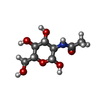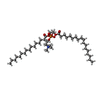[English] 日本語
 Yorodumi
Yorodumi- PDB-9n4m: Composite map for GluK2 in the apo state with 2-fold symmetrical ... -
+ Open data
Open data
- Basic information
Basic information
| Entry | Database: PDB / ID: 9n4m | ||||||||||||||||||
|---|---|---|---|---|---|---|---|---|---|---|---|---|---|---|---|---|---|---|---|
| Title | Composite map for GluK2 in the apo state with 2-fold symmetrical ligand-binding domain | ||||||||||||||||||
 Components Components | Glutamate receptor ionotropic, kainate 2 | ||||||||||||||||||
 Keywords Keywords | MEMBRANE PROTEIN / Kainate receptor / GluK2 / Ion Channel | ||||||||||||||||||
| Function / homology |  Function and homology information Function and homology informationmossy fiber rosette / detection of cold stimulus involved in thermoception / Activation of Na-permeable kainate receptors / kainate selective glutamate receptor complex / Activation of Ca-permeable Kainate Receptor / regulation of short-term neuronal synaptic plasticity / glutamate receptor activity / ubiquitin conjugating enzyme binding / negative regulation of synaptic transmission, glutamatergic / regulation of JNK cascade ...mossy fiber rosette / detection of cold stimulus involved in thermoception / Activation of Na-permeable kainate receptors / kainate selective glutamate receptor complex / Activation of Ca-permeable Kainate Receptor / regulation of short-term neuronal synaptic plasticity / glutamate receptor activity / ubiquitin conjugating enzyme binding / negative regulation of synaptic transmission, glutamatergic / regulation of JNK cascade / inhibitory postsynaptic potential / receptor clustering / kainate selective glutamate receptor activity / modulation of excitatory postsynaptic potential / extracellularly glutamate-gated ion channel activity / ionotropic glutamate receptor complex / positive regulation of synaptic transmission / behavioral fear response / neuronal action potential / glutamate-gated receptor activity / glutamate-gated calcium ion channel activity / presynaptic modulation of chemical synaptic transmission / ligand-gated monoatomic ion channel activity involved in regulation of presynaptic membrane potential / dendrite cytoplasm / hippocampal mossy fiber to CA3 synapse / SNARE binding / regulation of membrane potential / transmitter-gated monoatomic ion channel activity involved in regulation of postsynaptic membrane potential / synaptic transmission, glutamatergic / PDZ domain binding / excitatory postsynaptic potential / regulation of long-term neuronal synaptic plasticity / postsynaptic density membrane / modulation of chemical synaptic transmission / intracellular calcium ion homeostasis / terminal bouton / positive regulation of neuron apoptotic process / presynaptic membrane / neuron apoptotic process / scaffold protein binding / perikaryon / chemical synaptic transmission / negative regulation of neuron apoptotic process / postsynaptic membrane / postsynaptic density / axon / neuronal cell body / ubiquitin protein ligase binding / synapse / dendrite / glutamatergic synapse / identical protein binding / membrane / plasma membrane Similarity search - Function | ||||||||||||||||||
| Biological species |  | ||||||||||||||||||
| Method | ELECTRON MICROSCOPY / single particle reconstruction / cryo EM / Resolution: 3.77 Å | ||||||||||||||||||
 Authors Authors | Gangwar, S.P. / Yelshanskaya, M.V. / Yen, L.Y. / Newton, T.P. / Sobolevsky, A.I. | ||||||||||||||||||
| Funding support |  United States, 5items United States, 5items
| ||||||||||||||||||
 Citation Citation |  Journal: Nat Struct Mol Biol / Year: 2025 Journal: Nat Struct Mol Biol / Year: 2025Title: Activation of kainate receptor GluK2-Neto2 complex. Authors: Shanti Pal Gangwar / Maria V Yelshanskaya / Laura Y Yen / Thomas P Newton / Alexander I Sobolevsky /  Abstract: Kainate receptors (KARs) are tetrameric, ligand-gated ion channels of the ionotropic glutamate receptor family that mediate excitatory neurotransmission and modulate neuronal circuits and synaptic ...Kainate receptors (KARs) are tetrameric, ligand-gated ion channels of the ionotropic glutamate receptor family that mediate excitatory neurotransmission and modulate neuronal circuits and synaptic plasticity during development of the central nervous system. KARs are implicated in psychiatric and neurological diseases and represent a target of therapeutic intervention. Native KARs form complexes with neuropilin and tolloid-like auxiliary subunits (Neto1 and Neto2), which modulate their function, trafficking and synaptic localization. Here we present structures of rat GluK2 KAR in the apo closed state and in the open states activated by agonist kainate and positive allosteric modulator BPAM344, solved in the presence and absence of Neto2 using time-resolved cryo-electron microscopy. While the binding of Neto2 does not change the behavior of individual or dimeric ligand-binding domains (LBDs) or the ion channel, it prevents tightening of the interface between two LBD dimers during activation and slows the kinetics of deactivation. Our structures illuminate the mechanism of KAR activation and its modulation by Neto2. | ||||||||||||||||||
| History |
|
- Structure visualization
Structure visualization
| Structure viewer | Molecule:  Molmil Molmil Jmol/JSmol Jmol/JSmol |
|---|
- Downloads & links
Downloads & links
- Download
Download
| PDBx/mmCIF format |  9n4m.cif.gz 9n4m.cif.gz | 618 KB | Display |  PDBx/mmCIF format PDBx/mmCIF format |
|---|---|---|---|---|
| PDB format |  pdb9n4m.ent.gz pdb9n4m.ent.gz | 515.1 KB | Display |  PDB format PDB format |
| PDBx/mmJSON format |  9n4m.json.gz 9n4m.json.gz | Tree view |  PDBx/mmJSON format PDBx/mmJSON format | |
| Others |  Other downloads Other downloads |
-Validation report
| Summary document |  9n4m_validation.pdf.gz 9n4m_validation.pdf.gz | 1.9 MB | Display |  wwPDB validaton report wwPDB validaton report |
|---|---|---|---|---|
| Full document |  9n4m_full_validation.pdf.gz 9n4m_full_validation.pdf.gz | 2 MB | Display | |
| Data in XML |  9n4m_validation.xml.gz 9n4m_validation.xml.gz | 104.9 KB | Display | |
| Data in CIF |  9n4m_validation.cif.gz 9n4m_validation.cif.gz | 152.1 KB | Display | |
| Arichive directory |  https://data.pdbj.org/pub/pdb/validation_reports/n4/9n4m https://data.pdbj.org/pub/pdb/validation_reports/n4/9n4m ftp://data.pdbj.org/pub/pdb/validation_reports/n4/9n4m ftp://data.pdbj.org/pub/pdb/validation_reports/n4/9n4m | HTTPS FTP |
-Related structure data
| Related structure data |  48898MC  9n4lC  9n4nC  9n4oC  9n4pC  9n4qC  9n4rC  9n4sC  9n4tC  48880  48881  49066 M: map data used to model this data C: citing same article ( |
|---|---|
| Similar structure data | Similarity search - Function & homology  F&H Search F&H Search |
- Links
Links
- Assembly
Assembly
| Deposited unit | 
|
|---|---|
| 1 |
|
- Components
Components
-Protein , 1 types, 4 molecules ABCD
| #1: Protein | Mass: 102509.977 Da / Num. of mol.: 4 Source method: isolated from a genetically manipulated source Source: (gene. exp.)   Homo sapiens (human) / References: UniProt: P42260 Homo sapiens (human) / References: UniProt: P42260 |
|---|
-Sugars , 3 types, 26 molecules 
| #2: Polysaccharide | 2-acetamido-2-deoxy-beta-D-glucopyranose-(1-4)-2-acetamido-2-deoxy-beta-D-glucopyranose Source method: isolated from a genetically manipulated source #3: Polysaccharide | Source method: isolated from a genetically manipulated source #5: Sugar | ChemComp-NAG / |
|---|
-Non-polymers , 2 types, 20 molecules 


| #4: Chemical | ChemComp-POV / ( #6: Chemical | ChemComp-NA / |
|---|
-Details
| Has ligand of interest | Y |
|---|---|
| Has protein modification | Y |
-Experimental details
-Experiment
| Experiment | Method: ELECTRON MICROSCOPY |
|---|---|
| EM experiment | Aggregation state: PARTICLE / 3D reconstruction method: single particle reconstruction |
- Sample preparation
Sample preparation
| Component | Name: Composite map for GluK2 in the apo state with 2-fold symmetrical ligand-binding domain Type: COMPLEX / Entity ID: #1 / Source: RECOMBINANT | ||||||||||||||||
|---|---|---|---|---|---|---|---|---|---|---|---|---|---|---|---|---|---|
| Source (natural) | Organism:  | ||||||||||||||||
| Source (recombinant) | Organism:  Homo sapiens (human) Homo sapiens (human) | ||||||||||||||||
| Buffer solution | pH: 7.5 | ||||||||||||||||
| Buffer component |
| ||||||||||||||||
| Specimen | Embedding applied: NO / Shadowing applied: NO / Staining applied: NO / Vitrification applied: YES | ||||||||||||||||
| Specimen support | Grid type: UltrAuFoil R1.2/1.3 | ||||||||||||||||
| Vitrification | Cryogen name: ETHANE |
- Electron microscopy imaging
Electron microscopy imaging
| Experimental equipment |  Model: Titan Krios / Image courtesy: FEI Company |
|---|---|
| Microscopy | Model: TFS KRIOS |
| Electron gun | Electron source:  FIELD EMISSION GUN / Accelerating voltage: 300 kV / Illumination mode: FLOOD BEAM FIELD EMISSION GUN / Accelerating voltage: 300 kV / Illumination mode: FLOOD BEAM |
| Electron lens | Mode: BRIGHT FIELD / Nominal defocus max: 2000 nm / Nominal defocus min: 1000 nm |
| Image recording | Electron dose: 50 e/Å2 / Film or detector model: GATAN K3 (6k x 4k) |
- Processing
Processing
| CTF correction | Type: NONE | ||||||||||||||||||||||||
|---|---|---|---|---|---|---|---|---|---|---|---|---|---|---|---|---|---|---|---|---|---|---|---|---|---|
| 3D reconstruction | Resolution: 3.77 Å / Resolution method: FSC 0.143 CUT-OFF / Num. of particles: 56646 / Symmetry type: POINT | ||||||||||||||||||||||||
| Refine LS restraints |
|
 Movie
Movie Controller
Controller










 PDBj
PDBj




